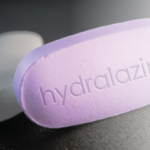His group found good results in a Phase I/II trial of rituximab in patients with noninfectious scleritis who haven’t responded to other treatments. “So it’s my go-to drug for scleritis [without] a systemic disease [and] that’s been refractory to other therapy,” he said.1
Suspected ANCA-Associated Vasculitis
Sharon Chung, MD, director of the Vasculitis Center at the University of California, San Francisco (UCSF), walked her audience through two cases that presented some of the complexities that can occur in suspected anti-neutrophil cytoplasmic antibody (ANCA)–associated vasculitis.
Patient 1
The first case involved a 59-year-old man undergoing treatment for Enterococcus endocarditis, with septic emboli with infarcts to the spleen, right kidney and brain. He was treated with ampicillin and ceftriaxone for a month, with negative blood cultures three days after starting the antibiotics. He began waiting for surgical repair of his aortic and mitral valves.
He then entered the clinic with small purpuric lesions on his legs and torso that were a week old, and with worsening shortness of breath and a cough that included blood. Diffuse alveolar hemorrhage was found on bronchoscopy the day before. His creatinine had risen from 0.9 to 3.0 mg/dL over the past month. He was PR3-ANCA positive.
He’d been on the anti-hypertensive hydralazine, and a chest CT showed diffuse bilateral parenchymal opacities with septal thickening and small pleural effusions, with no discrete nodules or cavities. A skin biopsy showed dermatitis with vacuolar change, and he was hypereosinophilic.
The disease possibilities included ANCA-associated vasculitis with pulmonary-renal syndrome, a drug-induced ANCA-associated vasculitis or just a set of unrelated events.
Dr. Chung said pulmonary-renal syndromes are caused by ANCA-associated vasculitis about 60% of the time, followed by p-ANCA combined with anti-GBM about 15% of the time, and anti-GBM alone about 4% of the time. Other causes, including SLE, account for the rest.
As for drug-induced ANCA, it can be brought on by anti-thyroid medications, antibiotics and other drugs such hydralazine and allopurinol. A 2014 study found ANCA positivity in patients with endocarditis, Dr. Chung noted.2
ANCA can also appear in nonvasculitic diseases. “It’s actually been detected in many autoimmune diseases,” she said.
In this case, doctors suspected drug-induced hypersensitivity syndrome. The patient’s hydralazine was stopped, and he was started on prednisone that tapered down over four weeks. He underwent mitral and aortic valve replacement, and his creatinine levels improved.
The final diagnosis: ANCA in the setting of endocarditis, with possible drug-induced vasculitis.


